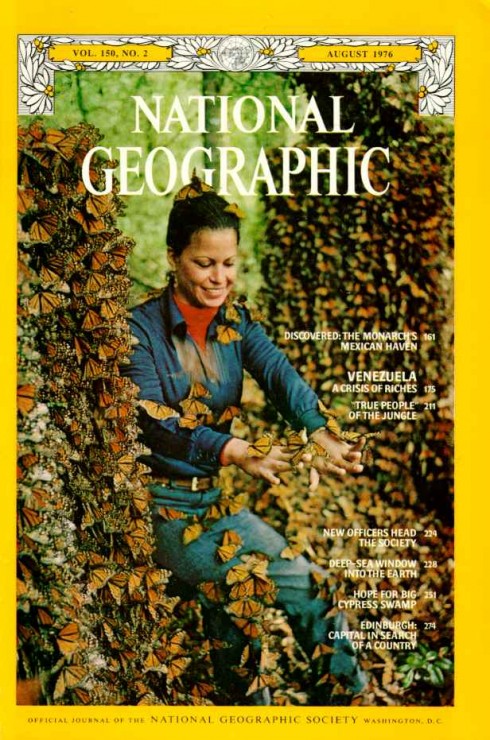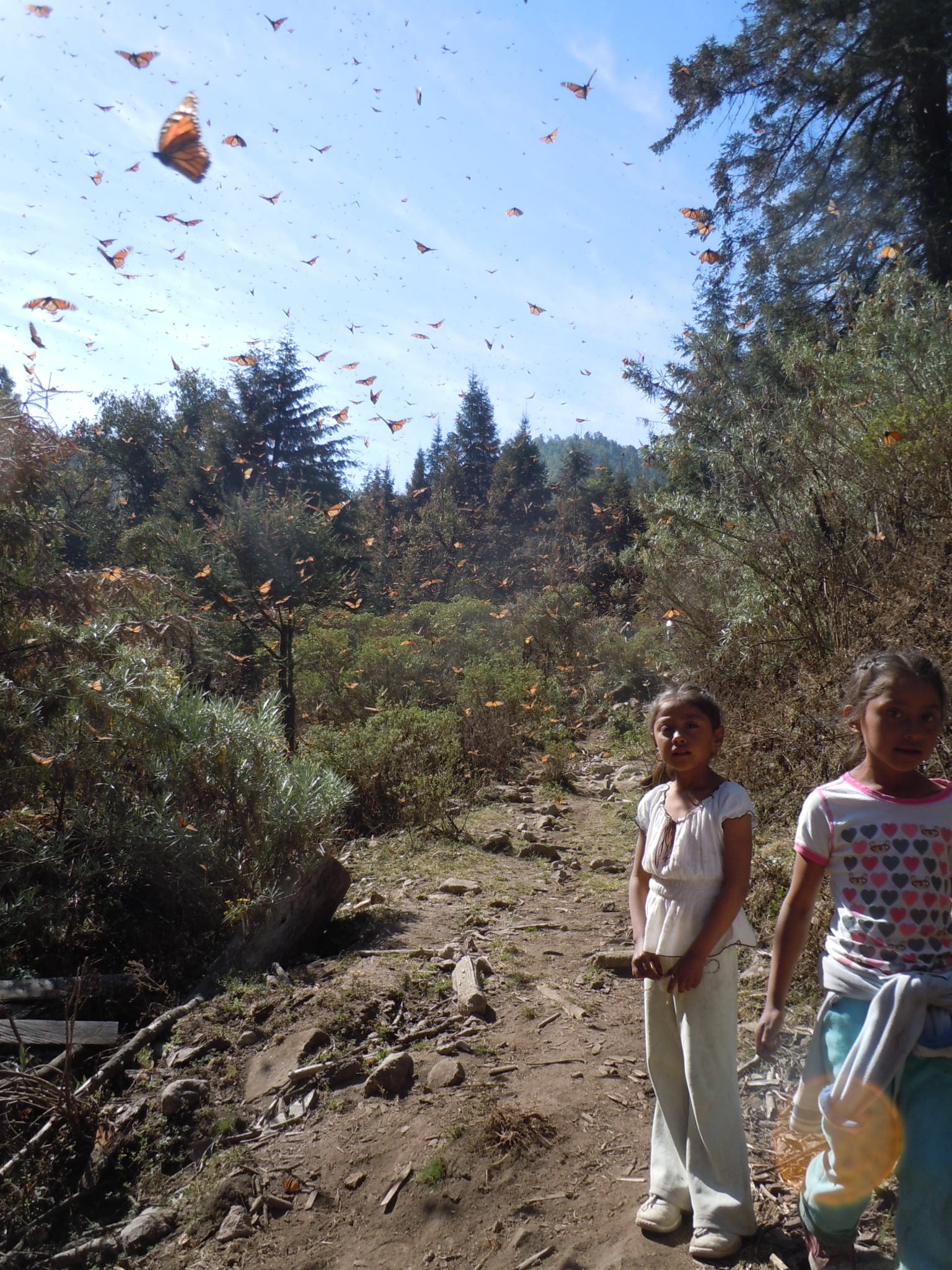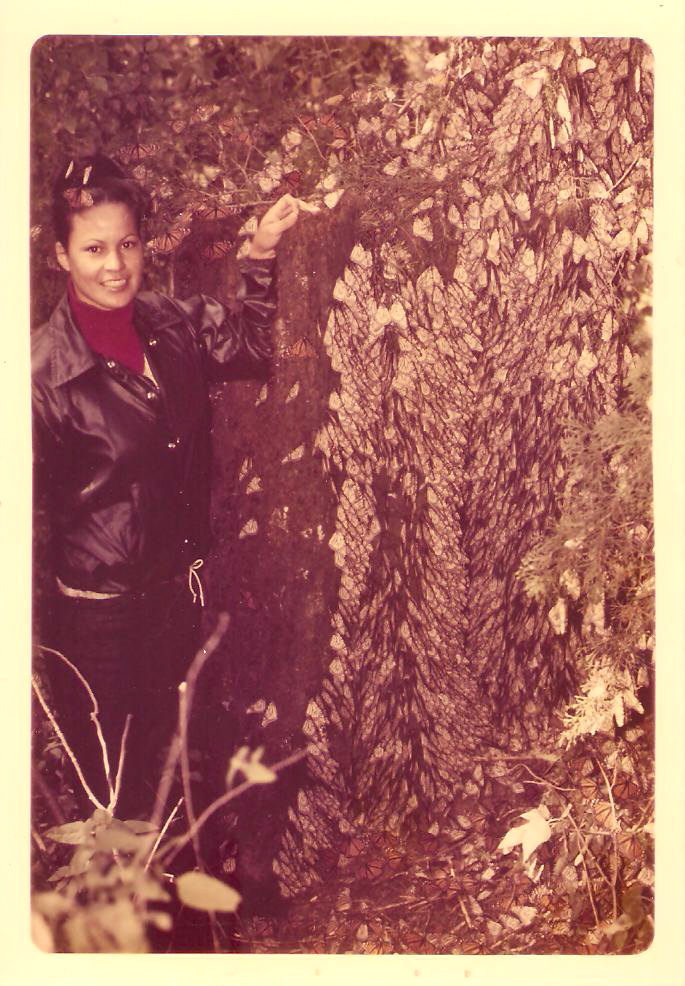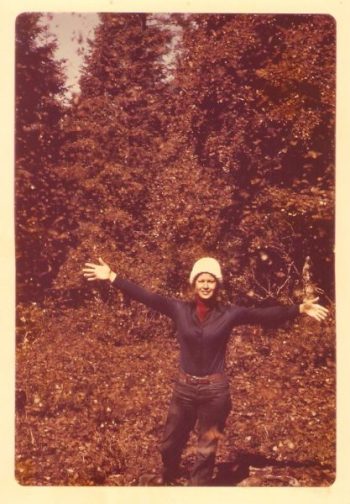I am the only living member of the team who discovered the Monarch Butterfly overwintering sanctuaries in Mexico in 1975. The discovery was published by National Geographic Magazine in August, 1976. My picture is on the cover. I was referred to as Cathy back then…I have been here in Austin living a quiet life and I am interested in participating in your Austin Butterfly Forum.
The best and brightest Monarch butterfly entomologists and citizen scientists gathered in Minneapolis in late June for the annual Monarch Butterfly Conservation Meeting hosted by the University of Minnesota. More than 100 Monarch aficionados, conservationists and citizen scientists joined academic heavyweights like Chip Taylor, Lincoln Brower, and Karen Oberhauser at the three-day “Monarch Geek Festival.” Participants enjoyed sessions on topics ranging from rearing Monarchs to conservation habitat management.
Yet one key player in contemporary Monarch history, a soft-spoken woman whose pivotal role helped unravel the mystery of the Monarch butterfly overwintering sites, was not in attendance: Catalina Trail of Austin, Texas.
“Cathy Aguado,” as she was known in 1975 when she and her partner Ken Brugger worked as “research associates” for Dr. Fred Urquhart, remained at her South Austin home. Trail now performs social work as a case manager for an Austin nonprofit organization, helping people face some of life’s toughest challenges. In her limited spare time, she tends her vegetable garden.
“I live a quiet life,” she said during a recent interview at a South Austin restaurant.
When Trail left a comment on the Texas Butterfly Ranch blog on May 24, I gasped audibly. Really? The woman busting through the magical wall of Monarch butterflies on the cover of the August 1976 National Geographic Magazine lives and works in Austin? Why have we never heard from her? And how many times had I looked at that photo and wondered: Who is she? What was she thinking? How did it happen? She’s so lucky.

Catalina Trail, January 2, 1975, the day she and Ken Brugger “discovered”
the Monarch butterfly overwintering sites Photo copyright Catalina Trail
Born on a ranch in the mountains at El Salto, in the Mexican state of Michoacan in 1949, Trail grew up outside Morelia, the state capitol. She and her partner Ken Brugger would be the first Westerners to walk among and make sense of the millions of Monarch butterflies roosting in the Oyamel trees of the Michoacan forest in Cerro Pelón, about 120 miles east of her birthplace.
Their “discovery”–and I use the quotation marks deliberately, since native people knew of the overwintering sites for centuries before Westerners pieced the migration puzzle together–occurred on January 2, 1975. Trail was 25 years old.
Trail had always displayed a sense of curiosity and adventure. As a child, she would sneak off to the library at the Universidad de San Nicólas de Hidalgo to peruse books on science. “I was the girl that played with insects,” she said, adding that after mountain rains, she would observe Mexican blues, Gulf Fritillaries and miscellaneous Swallowtails puddling in a seasonal stream near her house. “I’m not a scientist. I’m a gardener that likes insects.”
When she was almost 12 years old, Trail moved with one of her five sisters from the ranch to Morelia. By age 17, she was living in Mexico City, working at a pharmacy and later in sales for Philips Comercial.
During the 70s, she roamed the hemisphere, a fearless, free-spirited young woman who explored Mexico, Guatemala, El Salvador and many points south. She traversed the United States and Canada–alone and with friends. They rode buses and slept in cheap hotels, sometimes camping along the way, satisfying their wanderlust and search for adventure.

Catalina Trail, then known as Cathy Aguado, was the
woman on the cover of National Geographic in 1976
Trail was only 21 when she met Brugger, a smart, charming norteamericano, who worked as a self-taught engineer at textile giant Rinbros in Mexico City. Brugger loved trading the brutal winters of Wisconsin for the warmth of Mexico. He took every opportunity to explore the country from his Winnebago. A Canadian friend introduced the two in Acapulco when Catalina was taking a break from her Mexico City job and was visiting the Pacific Coast resort to attend immersion English classes.
Naturally, the 53-year-old Brugger found Trail captivating. “He followed me around,” said Trail. When she departed for a trip to El Salvador, “he wrote me letters on the back of a tortilla.”
Trail said she and Brugger first started looking for Monarch butterflies in 1973, a year before their marriage in Austin. Ken had seen an ad placed by Dr. Fred Urquhart in the Mexico City News, an English language newspaper, seeking “research associates” to help track Monarch butterflies. The job was voluntary at first, and Brugger thought it would be fun. “C’mon, want to do it?” he asked her. At first she hesitated. “Good luck with the campesinos and the Mexican government,” she said.
Ultimately, Brugger convinced “Cathy” as he called her, a name she never liked, to join the Monarch quest. Luckily she did, and surely her native smarts and Spanish fluency, plus her familiarity with the people and the countryside, proved key to locating the overwintering sites. Anyone who’s traveled in rural Mexico can attest to the suspicion native residents have toward outsiders. One could argue that were it not for Trail, the Monarch butterfly roosting sites would not have been revealed to the world in 1976. It would have happened, but later.
Brugger and Trail took weekend trips to Morelia throughout 1973 to look for Monarch butterflies. It wasn’t until 1974, as they came closer to finding the roosting spots and after reporting regularly to Urquhart of their progress, that the couple received compensation for their time — room, board, expenses, and car rental.
“That’s when we started taking it more seriously,” said Trail.

Catalina Trail in her South Austin vegetable garden. Photo courtesy Catalina Trail
In October 1974, Brugger and Trail saw pulses of Monarchs moving west from Mexico City. Urquhart had also received reports around that time that at least some of his experimental Monarch butterfly tags had been recovered northwest of the capitol. Evidence mounted that Monarchs were heading to Michoacán.
“We decided to go get supplies and topo maps,” said Trail. Because of work obligations, they had to squeeze their research into weekends and days off. “We knew where we had to look.”
Trail described several wild adventures, including Winnebago breakdowns and arduous climbs up difficult mountain trails. On their research excursions, she always carried photos of Monarch butterflies in their various stages, asking every campesino and viejo: have you seen these?
“Fred gave us some pictures from his collection, a mounted butterfly, and photos of butterfly, chrysalis and caterpillar,” said Trail. “I always told them: we’re doing it for science.”
Nobody they asked ever admitted to seeing the butterflies, she said. And this is where her story departs from accepted Monarch history. In the book Four Wings and a Prayer, author Sue Halpern relates a conversation with Brugger in which he describes dangerous encounters.
“‘We went through a lot of dangerous territory. People threatened to shoot us. They told us that Zapata had hidden some gold up there and they thought we were looking for that,’” Ken Brugger told Halpern in the book. In the National Geographic story, Urquhart describes a scene in which “Mexican woodcutters, prodding laden donkeys, had seen swarming butterflies and had helped point the way” to the roosting site.

Cerro Pelón in 2011. This was the first roosting spot found by
Trail and Brugger in 1975. Photo by Monika Maeckle
Trail tells a different story. “We went all along Route 15, Macho de Agua, El Capulín, Popocatepetl, and Nevado de Toluca areas, asking everyone. Nobody admitted to seeing butterflies like that–they didn’t know what we were talking about.” Trail said her former husband was not well in his old age. By the time Halpern interviewed him, sometime before the book’s publication in 2001, Brugger often spoke nonsensically. “That’s not the way it happened, and Ken never corrected that. I told him it was wrong and he said it didn’t matter.”
Trail said she and Brugger had hired a local “so we wouldn’t be alone” and routinely hiked 18 kilometers a day over the skirt of the mountain and back to their camper or inn at day’s end.
Finally, on January 2, 1975, the couple came upon Cerro Pelón, a dramatic high elevation summit that spills into an arroyo, or dry streambed. “That’s when we saw them,” recalled Trail.
The location hosted what seemed to be a Monarch butterfly superhighway and fir trees laden with millions of the roosting creatures. Occasional dead butterflies littered the forest floor.
Trail was first to the site. Brugger and their helper (you can see him behind Trail in the photo above) brought up the rear with food, water, and gear, including a camera that snapped the photographs reprinted in this story.
“I see them! I see them!” she yelled.
Two days later, they came upon Chincua and El Rosario.

Catalina Trail in Cerro Pelón, 1975, the first site “discovered”
by she and Ken Brugger. Photo copyright Catalina Trail
“That second day, it snowed,” Trail remembered. Brugger and Trail found five colonies on that trip and raced to Tuxpan to relay the news to Urquhart by phone. Urquhart recalled the phone call in the story he wrote for National Geographic. “On the evening of January 9, 1975, Ken telephoned us from Mexico. ‘We have located the colony!’ he said, unable to control the excitement in his voice. ‘We have found them–millions of Monarchs–in evergreens beside a mountain clearing.’ ”
An entire year later, Fred and Nora Urquhart, and photographer Bianca Lavies joined Trail and Brugger in Mexico to visit the roosting sites. The fantastic photo of Trail graced the front of the magazine, her historic role in the discovery reduced to cover girl and a vague reference by Urquhart to a “bright and delightful Mexican, ‘Cathy.’” The explosive story and dramatic photos inside rocked the world of lepidoptery.
Trail and Brugger returned to Michoacan in 1978 together for the last time. “I was almost sad that we had found them because everything was in such disarray in the first few years,” said Trail recently. “And there was a lot of controversy,” she said, referring to myriad disagreements about scientific credit-taking that followed. The drama and disagreement explains why Trail dropped out of the Monarch story for decades. Halpern’s book, Four Wings and a Prayer, chronicles the saga.
Trail and Brugger, married for 18 years, separated in 1991. Her desire to earn a formal education at Austin Community College seemed to unnerve her older husband and caused problems. They eventually divorced, and in 1995 Trail married a fellow social worker, George Trail. In 1996 Trail graduated with a degree in social work from the University of Texas at Austin. Brugger died at age 80 and his grown son by Trail, whose privacy she chooses to protect, also lives in Austin.
Trail returned to the roosting sanctuaries in February for the first time in 34 years. Canadian filmmakers invited her as their guest in the course of filming the documentary, Flight of the Butterflies.
“During the trip from Mexico City Airport to El Rosario, federal and state police patrolled the roads and the sanctuary,” she said, describing “mixed feelings of safety and dread, which surprised me as a native Mexican in Michoacan.” Trail missed an opportunity to meet President Felipe Calderon who took part in the IMAX film, since her return to Austin was scheduled prior to his arrival at the Monarch sanctuaries.

Trail was first to the site at Cerro Pelón on January 2, 1975.
Photo copyright Catalina Trail
For Trail, as for many of us, a fascination with Monarch butterflies is almost impossible to shake. She’d like to get involved in Monarch conservation again and plans to attend future meetings of the Austin Butterfly Forum. Since she doesn’t spend much time on the computer, she doesn’t participate in the hyperactive online Monarch butterfly information exchange. “I’d rather look at the tassels of my corn and hope the pollen will fall down and pollinate,” she said.
Her journey to find the Mexican mountain home for Monarch butterflies, and her place in Monarch history, remain. A few years ago, about 100 Monarchs roosted in her garden one fall evening. It was a reunion of sorts.
“I had my own little colony, and I stayed up all night.”


Hello, please, I’m looking to purchase milkweed plugs to plant in my Santa fe, NM backyard of 2 acres. I want the wild Mexican variety. Is this impossible to find? Please advise. Thank you, Debra
Hello! I am writing a piece for Edible Austin about Monarch butterfly conservation, and what gardeners in the Austin and Central Texas area can plant to help the butterflies during their migration. I would LOVE to include some thoughts from Ms. Trail. Can you possibly connect me with her?
Thank you for your help!
Cari Marshall
Hello, loved this article about Catalina Trail and the Monarch butterfly discovery events in 1975. I am a Mexico travel/trip planner and just booked a trip to Mexico’s butterfly sanctuary, Piedra Herrada, for a lovely couple who have a very special attachment to Monarch Butterflies. I told them I thought I had read that it was at Piedra Herrada/Cerro Pelon where Fred Urquhart found that famous butterfly tag. Perhaps you, or Catalina, can confirm if that is true? I would so appreciate your comments! Many thanks in advance.
Barbra Bishop
I realize this article was written two years ago but I want to thank Monica Maeckle for re-telling Catalina Trail’s remarkable tale of persistance which led to the discovery of the Monarch colonies by she and her husband almost 40 years ago. Unfortunately, she became somewhat of a footnote to her own story once the discovery was made and the researchers took over. The fact that her true role was not acknowledged even by the magazine whose cover she graced was an injustice. Catalina, I am sorry that you have remained so far removed for all these years from the enthusiasm and attention of the scientific community and butterfly lovers around the globe that you generated. We are all grateful to you for the perseversence and tireless effort you gave. I hope you will re-join the community which you helped to create.
Amen, sister. An all too-common tale. Thanks for writing. –MM
THANK YOU BARB AND MONIKA!
I appreciate your kind words and acknowledgement of my role in the discovery of The Monarch Butterfly Overwintering Sanctuaries in 1975. I understand the motivation and needs of those who chose to not include my name in their publications. It must have been of great importance for them to do that. As for the Monarchs, I will always have a very special place in my spirit for them. THEY ARE AMAZING CREATURES JUST AS AMAZING AS THE PEOPLE WHO LOVE THEM SO MUCH… Kindly,
Catalina.
HI! Catalina, creo que usted entenderá mejor si escribo esto en español ya que mi inglés no es muy bueno. Soy mexicana y llegué a su historia porque estoy haciendo unas pequeñas ilustraciones acerca de varias mujeres mexicanas que se hayan acercado a diferentes rubros; ciencia, literatura, artes, entre otros. Me interesó muchísimo su historia y tengo sentimientos encontrados al igual que dudas y cosas que me dejan un vacío no de “decepción” más bien de preocupación y de curiosidad ¿por qué dejó la investigación de las monarca? ¿alguna vez sintió que aquella investigación se convertía en “invasión”? ¿a qué se refiere aquello de “se perdió la oportunidad de conocer a felipe calderón”? sabiendo claro, el tipo de persona y las consecuencias políticas que gira en torno a ese tema. No sé, me interesa mucho la voz que tenga dentro que pueda responder a esto, igual podría ser grosero de mi parte pero si pudiera contestar o mantener una comunicación. Gracias
Catalina,
In 1976 I was in sixth grade and sat in my sister’s closet and read that National Geographic article. I stared at your beautiful picture on the cover and the monarchs stole my heart. I told myself, “I want to see this someday!” Now I am the sixth grade life science teacher and I try to inspire my children with a yearlong conservation project on how they can help support the migration. Last weekend was my 27th anniversary and my husband gave me the original ’76 Nat. Geo. magazine, the same cover I was in awe with as a girl. I held it up in my class that Monday and the students gasped, they saw the ‘real’ cover that I showed them in my powerpoint on the first day of school.
To me, your face, discovery and story has been an inspiration for years. I was looking for an electronic version of the ’76 article to assign to my students to read and made my way to this website and the article above. Making a connection with you, as silly as it sounds, is like finding a part of my childhood. I cannot believe you reside in Austin and I am in Fort Worth.
Your story is intriguing, amazing and heartfelt. Thank you so much for sharing with us all!
Julie Frey
My name is Jill Harris. I recently found 3 monarch butterfly caterpillars. I spent 2 days trying to find someone to help me know how take care of them because it was going to be cold here in Ben Wheeler Texas. I did not find anyone to help me until Saturday. I found a lady who owns Evas Butterfly Farm and she helped make the decision to bring them inside. What a wonderful chose I made. I love them and enjoy taking care of them and watching them change. Only 1 has entered its final stage. The other 2 or just eating and pooping. But I know I will have to release them. This saddens me because I do not know if they will make it to Mexico. It will be approximately 2 weeks do you think they will make it.
Jill,
I have raised many monarchs and it sounds like your larva are eating and doing great. Bringing them inside was a wonderful choice, the warmer it is, the quicker they will go through the larval instars and metamorphosis. I believe they will be fine to release and migrate to Mexico. I attended the Univ. of Minnesota Monarch Lab over the summer and had a similar question with late emerges. With the cues of temperature and shortened daylight hours, their instinct will tell them to travel south. I am in Fort Worth and would love to send you tags so you can tag them and release. My monarch project has a facebook page if you want to stay in touch: Monarch Project VI Julie Frey. Good luck and let me know if I can help more!
Julie
Julie how do I find you on FB? We are starting a monarch project here in Elgin, TX to add way stations. I hope to connect with Catalina in Austin too.
Sue,
I apologize that this is so late. Our page is called ‘Julie Frey Monarch Project 6’. I would love to stay in contact.
Julie
Greetings; Presently I’m a TX Master Naturalist with the Galveston Bay Chapter. I met Mrs Trail at Moody Gardens 2 years ago while giving a Monarch Exhibit and presentation during the IMAX Monarch Movie. Tagging, Oe Sampling and giving Monarch Presentations to Schools, MasterNaturalist and who ever else that has a desire to learn about Monarchs is a passion with me. I have worked closely with University of Georgia, School of Ecology and in particular, PhD. Candidate Dara Satterfield, who heads the MonarchHealth team. Working with Monarchs for the last 5 years and still going strong.
Interesting article. My question is How did the sanctuary get its name “Piedra Herrada Sanctuary ?
That’s my Great Aunt!! How can I contact her? My Grandma was diagnosed with Alzheimer’s disease almost 3 yrs ago and I want to know if Catalina would like to see her before she starts to forget relatives. Please let me know if you could help. Thnx 🙂
I would love to meet Catalina. I live in Temple and have studied and read so much about Monarch butterflies and their migration to Michoacán. My mother is from Durango, Mexico and I learned early on the beauty of the mountains there and the respect for wildlife and the conservation. I travel to Mexico one or twice a year and would like to one day make it to Michoacán. I, too, was surprised by the sense of nervousness/fear in traveling certain parts of Mexico. It is not the Mexico I remember. Anyway, I am still planning on making a trip next year in October or so. If Catalina could respond or email, I would feel so honored to speak with her! Thanks for taking us back to the year when you discovered them for us all.
I had the great pleasure of meeting Catalina at a pollinator conference in Kerrville, TX. I had my preteen daughter with me and Catalina was so gracious to talk to her and have her picture taken with her. I sincerely believe that Catalina should write the story of the monarchs for all of us to enjoy! I love telling the story of how the monarchs were discovered. I am also in Fort Worth and a member of the Fort Worth Chapter of the Native Prairies Association of Texas. We are working on monarch awareness and milkweed preservation through prairie conservation and encouraging non mowed areas to promote natural milkweed seed production. I encourage anyone in Texas to check for an NPAT chapter that is close to you. We are growing and new chapters are opening. Thank you for this amazing article!
There’s certainly a lot to know about this subject. I
like all of the points you’ve made.
I am SO enjoying this story, and all of the activities of Texas Butterfly Ranch! But please make this word correction to this story > it should be “FINDER of butterfly roosting site,” as the sites were already established (founded) when young Catalina made it her goal to FIND them. Thank you for your attention to this matter.
Yesterday over lunch my younger brother told a story from his youth of exploring some ranch property near our residence in the late 70’s in what is now the Gracy Woods subdivision in North Austin, and stumbling upon a few trees absolutely covered in thousands of monarch butterflies. I was amazed because I’d never heard him mention this previously, and even more so by the fact that I too had seen this phenomenon myself during similar explorations of the same land. While he didnt recall the exact location where he had seen them, I do know exactly where I saw them. It was just north of the present day intersection of Knoll Park Dr. and Austin Park Ln. Do monarchs congregate in huge numbers on the way to and from their overwintering location? Or is it more likely that what we saw were in fact long lost overwintering sites here in Austin?
Monarchs congregate in clusters or roosts in the fall when masses of them funnel through Texas on their way to Mexico. We have them every year along the Llano River at our ranch. Here’s a story that will help you get a picture https://texasbutterflyranch.com/2021/04/22/two-monarch-butterflies-tagged-on-the-llano-river-in-honor-of-lost-loved-ones-recovered-in-mexico/
Thanks for reading and writing. –Monika